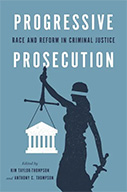Progressive Prosecution: Race and Reform in Criminal Justice

Authors: Kim Taylor-Thompson & Anthony C. Thompson
Publisher: NYU Press 2022. 312 pages.
Reviewer: Justin Murray | September 2022
Prosecutors wield extensive discretionary power in the U.S. criminal justice system — power that can be used to advance a variety of goals. On one hand, prosecutors can leverage their control over charging, bail, plea negotiation, sentencing, and other key stages of the adjudicative process to mass produce criminal convictions and severe punishments. This is the path most prosecutors have chosen, most of the time, throughout America’s decades-long tough on crime era. Prosecutors certainly did not act alone in orchestrating the vast expansion of the American carceral state that took place during the latter half of the twentieth century (and extending into the first decade of this century) — they had many willing enablers. But their cooperation in this project was indispensable to its success. By choosing to convert most police arrests into criminal charges, by filing felony charges — often tacking on gratuitous sentence enhancements for good measure — when misdemeanor charges or noncriminal interventions would suffice, by threatening inflated charges or punishments for defendants who exercise their right to a trial, and by persuading lawmakers to give them an ever-growing array of tools with which to criminalize and punish people, prosecutors have played a critical role in making the United States the world’s leading incarcerator and in burdening millions of people with the stigma of a criminal record. People of color, the poor, and people with disabilities are drastically overrepresented in America’s criminal courts, jails, and prisons, and this reality, too, is attributable in no small part to the choices prosecutors have made regarding what conduct, and which people, should be selected for criminal enforcement.
On the other hand, the broad discretion American law entrusts to prosecutors also creates conceptual room for alternative approaches to criminal prosecution animated by different sets of objectives. Until very recently, this theoretical possibility went largely unrealized. But starting around 2015 — fueled by the nascent Black Lives Matter movement and burgeoning political mobilization against police violence, mass imprisonment, and racial discrimination in the administration of criminal justice — reform-oriented candidates began contesting local district attorney (“DA” for short) elections, running on platforms centered around unfamiliar (to prosecutors) themes such as holding police officers accountable for criminal acts of violence, dismantling mass incarceration, expanding alternatives to criminalization and punishment, ending the war on drugs, and reducing racial disparities in criminal enforcement. A trio of initial electoral victories for reform candidates in Mississippi and Louisiana in 2015 prompted national criminal justice reform organizations and funders as well as grassroots activists to devote greater resources and attention to DA elections. Then, within the span of just a few years, reformers won DA elections in dozens of cities and counties across the country — mostly in large urban centers like Chicago, Philadelphia and Boston, but also in some smaller cities and rural areas as well. According to a recent estimate, reformers now hold power in prosecutors’ offices that serve around 20 percent of the U.S. population.
This new cohort of prosecutors and the work they are doing to improve the administration of criminal justice in America are the focus of a new edited volume entitled Progressive Prosecution: Race and Reform in Criminal Justice (“Race and Reform” for short). The book’s contributors bring a rich variety of professional experiences to the project, with several chapters authored by academics whose research concentrates on race and prosecution, others by elected DAs who are actively engaged in efforts to reform the prosecution offices they lead, and one by a reform advocate who directs a local branch of an influential criminal justice-oriented nonprofit. Taken together, Race and Reform’s seven chapters cover many different facets of prosecutorial reform — from vision-building, policy change, and leadership strategies to staff diversity, community engagement, data transparency, and more. Yet the contributors examine each of these discrete topics through the common lens of race and racial justice. As the editors explain in their Introduction, “[t]he American criminal legal system continues to be the place where deeply embedded racialized perceptions shape decisions about who deserves punishment and who does not,” and so “[r]eckoning with the effects of racism and poverty must take center stage as we look to reimagine the future of the criminal justice system” (p. 8).
It is not so simple, of course, for prosecutors (or indeed anyone) to disrupt the entrenched practices, ways of thinking, and policies that make the American criminal justice system such a powerful engine for creating and sustaining racial hierarchy. Race and Reform contends that the work of prosecutorial reform has be anchored in a radically different vision of the prosecution function if it is to succeed in achieving genuinely transformative change instead of merely tinkering around the edges. What, then, does this alternative vision look like? Equally important, what process should be followed — and which stakeholders should have a seat at the table — in formulating, articulating, and then implementing such a vision? The book engages deeply with each of these questions (and then some).
As to the first question, many of the book’s contributors begin with the premise that a prosecutor’s overriding goal must be the pursuit of justice. For most lawyers practicing within America’s putatively adversarial legal system, the primary ethical responsibility of a lawyer is to vigorously advance the interests of one party to a dispute — the client — and leave it to others (e.g. a judge or jury) or to the process of adversarial contestation itself to determine what justice demands. But the prosecutor’s role — indeed, even the conventional, non-reformed understanding of that role — is distinctive. Like other lawyers, prosecutors are expected to advocate effectively for the interests of their “client” (a prosecutor’s client is often assumed to be the government, or crime victims in cases where there is a victim) and to engage in adversarial combat with their client’s foes (i.e. criminal defendants, in the conventional model). At the same time, however, prosecutors are supposed to strive for justice — the very thing that lawyers, as adversarial advocates, are told to put out of their minds and entrust to the invisible hand of the adversarial system to work out on its own. Thus, at the heart of the conventional understanding of prosecution is a complex dual role that is notoriously difficult to harmonize on a conceptual level, let alone operationalize in practice. This presents a risk that some prosecutors — flummoxed by their conflicting role expectations and impelled, at least in part, by a desire to “win” and thereby garner professional acclaim — will set out to maximize criminal convictions and severe punishments with little concern for truth or fairness in individual cases or for the social and systemic cost of their litigation victories. Thus, one essential component of a reformed vision of prosecution, according to Race and Reform, involves reorienting the role of the prosecutor toward justice and de-emphasizing the adversarial component of the conventional approach to prosecutorial ethics.
But while this insight is helpful as a starting point, the book’s contributors rightly recognize that more is needed to transform criminal prosecution than a heightened sense of obligation to seek justice. After all, many conventional prosecutors ardently believe the work they are doing is geared toward justice, since what justice means to them, at least in the context of criminal law enforcement, is standing up for crime victims, keeping the public safe, maintaining order, and giving wrongdoers their just deserts. A renewed commitment to justice, therefore, must come paired together with a more capacious understanding of what justice entails.
It is here that Race and Reform truly shines. For instance, Professor Anthony Thompson argues in his contribution that, in light of longstanding and deeply embedded racial disparities in enforcement of the criminal law, prosecutors will have to “embrac[e] a progressive, race-alert vision . . . in all prosecutorial decisions” — a vision centered on “examin[ing] the ways that race influences discretionary decision-making” — in order to correct past injustices and foster racial justice in future cases (pp. 21, 27). Dan Satterberg, the elected DA for King County (Seattle), lays out a detailed policy agenda organized around what he terms “the Five Pillars of Criminal Justice Reform”: (1) diverting and deflecting cases involving low-level offenses out of the criminal courts; (2) elevating public health strategies over criminal law responses to substance abuse disorder; (3) pushing for reforms that make the criminal process fairer and sentencing less harsh; (4) amplifying demands for prison reform; and (5) helping returning citizens and formerly incarcerated people successfully reintegrate into the community following imprisonment (p. 55). Professor Angela Davis offers a broad-ranging national survey of recent policy shifts embraced by reformist DAs relating to issues as varied as cash bail, charging, diversion, wrongful convictions, death penalty, juvenile justice, and police accountability. William Snowden, Director of the Vera Institute of Justice’s New Orleans branch, explains why core aspects of prosecutorial decision-making are susceptible to implicit racial bias and suggests steps individual prosecutors and their offices can take to reduce these risks. Professor Kim Taylor-Thompson’s contribution focuses on the juvenile justice system, arguing that prosecutors far too often treated justice-involved children as though they were adults — especially Black children, who are likely to be perceived as more adult-like and blameworthy than a similarly situated White child — and that prosecutors who handle juvenile matters should apply “a racially alert, developmental lens” informed by neuroscience and implicit bias training (p. 202). In short, Race and Reform is brimming with ideas that could be, and in some locales already have been, incorporated into a substantive vision for prosecutorial reform.
The book also sheds valuable light on the process by which a would-be reformer should go about developing a compelling and collaborative vision for change and then making that vision real. Whereas many journalistic and scholarly analyses of prosecutorial reform revolve around the personalities and policy pronouncements of this or that reformist DA or DA candidate, as if transformative change were simply a matter of electing the right person with the right ideas, Race and Reform envisions a more complex, collaborative, and at times conflictual process that requires engagement with a range of different stakeholders. Cook County (Chicago) DA Kim Foxx’s chapter emphasizes that ambitious policy shifts must be accompanied by comparably far-reaching changes in institutional culture if they are to prove effective and durable. Professor Don Stemen makes the case that prosecutorial reformers should modernize their offices’ data collection systems — and, relatedly, take steps to share prosecutorial data with the public, leverage data to inform policy, and train prosecutors in data literacy — to promote evidence-based practices, transparency, and accountability. And just about every chapter of the book wrestles with the fact that reformist DAs are facing intense blowback right now on multiple fronts: from prominent media figures, from state governors, from judges, and even from the line prosecutors whom the DAs employ to effectuate their policies in court.
The editors of Race and Reform hoped this volume would provide “guidance to district attorneys and their staffs to help them shape a new culture within their offices” while also “educat[ing] a broader audience — students, readers, researchers, and the general public — about the importance of a race-sensitive, community-based prosecution function in making real change in the criminal justice system” (p. 10). The book will prove to be an outstanding resource for each of these audiences, and for anyone seeking to better understand the push to reform criminal prosecution in America.
Justin Murray is an Associate Professor of Law at New York Law School.


